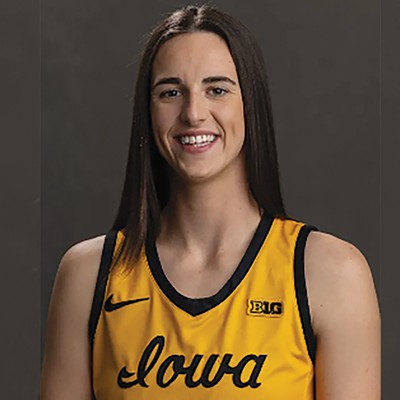A few months ago, there was an editorial cartoon in the Arizona Daily Star in which a dad and mom were explaining to their teenage son, "We're middle class. We're just not club sports middle class." That's a brutal insight into a phenomenon that began a couple decades ago as a rather unwelcome intrusion into the natural order of athletic experimentation and discovery for young people.
Today, in Tucson and around the entire country, intrusion has given way to imposition, experimentation has been supplanted by enforced structure, and public dissent can only come from someone who doesn't have any skin in the game...in the incredibly expensive game.
Nationally, the numbers are staggering. According to WinterGreen Research, youth sports is at least a $15 billion/year industry, eclipsing the NFL's $14 billion figure and growing at an incredible rate. (WinterGreen says that spending on youth sports has increased by more than 50 percent in just the last eight years.) Estimates vary, for a variety of reasons. Some of the individualized training is on an under-the-table, cash basis. There is some disagreement as to what constitutes expenses for youth sports; club fees and travel costs are easy to track, but money is also spent on such things as phone apps that allow for the live streaming of club tournament games.
And there is the fact that many parents don't want to admit—even to themselves—exactly how much money they're pouring down that hole in pursuit of what can't even generously be called an elusive dream.
According to statistics from the National Collegiate Athletic Association (NCAA), only about two percent of high-school athletes will ever play Division I sports in college and not even all of them will have earned a scholarship.
From the very beginning, things didn't feel exactly right. The clubs hold open tryouts that last a couple hours. After that brief period, the coaches break the kids up into groups according to age and perceived ability. There are 14-1s and 16-4s and all kinds of number combinations. The -1s are the "elite" travel teams for each age group. The -2s might also travel, although not as much, while the -3s, -4s, and, God forbid, the -5s and -6s, depending in the number of kids who try out, mostly practice a lot in hopes of getting a different numerical designation somewhere down the road.
"I feel bad for the kids," she explains. "The ones who don't make the elite travel teams are crushed. They feel that their athletic fate has been sealed."
Her daughter made a travel team and then came the bill that was in the thousands of dollars. "I knew it was going to be expensive, but I didn't know it was going to be that expensive. They did a good job of explaining where all the money went—for coaching and gym rental, uniforms and equipment, travel and tournaments. Sooo many tournaments. Vegas, L.A., Phoenix, even Chicago. I remember thinking, 'I should be in the business of putting on youth volleyball tournaments.'"
Her daughter had always been a multi-sport athlete, but one look at the practice schedule and they both knew that basketball was out. The official stance of the club is that kids are encouraged to play multiple sports at their respective schools, but if there is a conflict between the club schedule and the school schedule, kids will tend to go with the one for which their parents are shelling out the big bucks. Another look at the tournament-heavy latter part of the season meant that spring school sports were probably out, as well.
As the season progressed, Erika became increasingly uncomfortable. She could tell that her daughter wasn't enjoying the experience, but at first there wasn't anything she could actually put her finger on. The coaches knew what they were doing, the practice venue was first-rate and the organization ran smoothly. But then things began to take a Strangelove-ian turn. It's as though the players and parents felt there was a chance that they could fall victim to a dedication gap. None of the other kids on her daughter's team played anything other than volleyball for the schools. It would have been seen as not going all in. And they all had gym memberships where they could lift weights on days that they didn't have practice.
"I think the turning point was when (my daughter) said that she needed a personal trainer because all of the other kids had one. And not just any trainer! She had to have the best trainer, the $100-an-hour trainer. When we said no to that, it was something of a turning point. She never came right out and said it, but I felt as though her attitude was one of 'Why do this if we're not going to do it all the way?'"
Erika began to question herself as to whether it was a matter of money or one of principle. If the club was as good as it claimed to be, why would she need an outside trainer? But that philosophical question was swept aside by more practical concerns. Her daughter had to miss school in order to meet the travel logistics for out-of-town tournaments.
That was nothing, however, when compared to one of the big late-season qualifying tournaments.
The Windy City National Qualifier was held March 30-31 and April 1—Good Friday, Holy Saturday and Easter Sunday. "We're religious people," Erika explains. "And as Christians, we realize that the most important day of the year for our faith isn't Christmas; it's Easter. And they expect my daughter to be playing volleyball when we should be worshipping?"
When she voiced her concerns to the club, she was met with a shrug. She was told that if her daughter didn't make the trip, they would forfeit the money that had already been paid and, they added, someone else would have to play in her spot. Wink, wink.
Erika and her daughter both made the trip; Erika regrets having done so.
And if you're thinking that it was just bad luck, that the tournament is usually held the last weekend of March and it just happened to coincide with Holy Week in 2018, you can go online to Windy City National Qualifier and see the countdown clock for next year's tournament that will be held April 19-21—Good Friday, Holy Saturday and Easter Sunday. On the website, in small print, it says that "a non-denominational Easter Sunday service will be held from 6:15 a.m. – 6:45 a.m. in Room S-100."
He is risen...now serve the ball!
Local sports fans who don't have athletic kids in the club sport age range might simply sniff at the mess that is youth sports and casually dismiss it as the confluence of over-indulgent parents and conniving capitalists all too willing to create for gullible consumers a supply for a demand that really shouldn't exist. If parents want to throw away thousands (or tens of thousands) of dollars in a quixotic (no, vicarious) quest to buck 50-1 odds against their kid getting an athletic scholarship, who really cares? But, if it touches close to home, attention must be paid.
This is a relatively dark period for University of Arizona athletics. The football team is playing in front of maybe 50 percent capacity at Arizona Stadium. The once-mighty women's softball team hasn't been to the College World Series in half a generation. And the men's basketball team is stumbling around with an NCAA cloud hanging over its head. On top of having become the team that every other school wants to play in the first round of the NCAA Tournament, Arizona is looking at some serious trouble from the capricious and lumbering NCAA. The risk of sanctions is scaring away recruits, making Coach Sean Miller even more sour than before and leaving a stain (thus far, mostly contained) on the legacy of a program that, for better or worse, is that which gives Arizona its most prominent national profile.
All last fall (and then into the winter and spring), the UA's name was splashed across the tabloid headlines along with ugly phrases like "bribery," "illegal cash inducements" and "coach suspended, then fired." Ultimately at the root of all that evil is AAU basketball, which is nothing more than club sports writ large...on steroids...with an exclamation point!
From the time that kids are halfway through elementary school, they are aware of the allure of playing on club teams, many of which have in their names "Elite" or "Stars," words that do wonders for the emotional stability of 9-year-olds. Their parents fork over the money and the kids participate in these two- or three-day extravaganzas, highlighted by sketchy coaching, non-fundamental play, and boorish fan behavior.
By the time they're in middle school, those who have been identified as having a chance of becoming truly elite have been grabbed up by AAU teams. The big difference here is that these players get a lavish free ride. All of their club expenses are covered by athletic shoe companies (mostly Nike and Adidas, although lately Under Armour and Puma have begun dumping large bundles of cash in the swamp).
With a hysteria fueled by social media and cable sports outlets with a ravenous hunger for content (last month, ESPN had cornhole competition), AAU has gone from being a suspicious growth on the underbelly of amateur basketball to being this Thing. In a couple weeks, Las Vegas will host the summer season-ending AAU Showcase, with college coaches descending on the place, perchance to pick out their recruiting targets for the next couple years. (If you ever want to send Sean Miller—or most any other D-I coach—into a paroxysm, just suggest that one way to cut down on the corruption in college basketball would be to ban coaches from the AAU tournaments, causing the tournaments and the shoe money to dry up almost immediately.)
What, then, can be done? Ask 100 people who are coaching club teams and 105 of them will say that they do it to counterbalance all of those who are in it for the wrong reasons and/or do things the wrong way. Certainly the stories of the coach who absconds with the team's money (as happened in Marana just a few months ago) or the one that exhibits inappropriate behavior in practice or in a game (as happens everywhere, all the time) are far more likely to get the attention of the media. But there are those who put in their work, give their time, and reap their rewards in other ways.
Ismael "Izzy" Galindo has been at both ends of the won-loss spectrum. He likes where he is now, but he appreciates the time he spent at the other end. At the beginning of this decade, Galindo took over the dismal girls basketball program at Pueblo High School. It had been years since the Warriors had a winning record and even longer since they had gone to state. "I knew we had a lot of work to do, so that's what we did. Work."
He gathered a few kids who were willing to put in the time and effort and even reached down into Pueblo's feeder schools on the southwest side of town. "We spent the first couple summers playing against big-school varsity teams and we were using seventh-, eight- and ninth-graders. We took a whole lot of beatings, but we knew we were heading in the right direction. But I had to make it clear that we couldn't compete with those club teams on a financial basis; it just wasn't realistic."
They did fundraisers and got donations and eventually built up a hybrid program that serves the community and feeds into the school. Last season, Pueblo's girls made it to the Class 4A State Championship game.
Not long ago, one of those aforementioned club tournaments was held at a local sports venue. I thought I would stop by and interview one of the coaches. I happened to see a 40-ish man whom I had known since he was in high school. (We'll call him Jesse.) I watched him pace up and down the sidelines, yelling at the refs, yelling at his players, getting into it with some of the fans, and even crossing a big line by talking to players on the other team. Not surprisingly, his players mimicked his actions, griping about the refs' calls, talking crap to their opponents and occasionally even saying things to some of the other team's parents (who, admittedly, should have been the adults in the room.)
As the tight game neared its conclusion, I realized that I would have to make a decision as to whether to interview Jesse and ask whether he thinks his behavior is helping or hurting the kids in his charge or simply walk up to him and, after not having seen him for 15 years, give him my most sincere "WTF?!"
His team ended up losing by a couple points. Shortly after the buzzer, the two teams lined up to slap hands and utter the perfunctory "Good game. Good game." Jesse took his customary place at the end of the line and slapped five with the opposing players. When he got to the end of the line, the opposing coach extended his arm to shake hands. Jesse punched the other coach in the face, knocked him to the ground and just kept on walking.
WTF, indeed.












